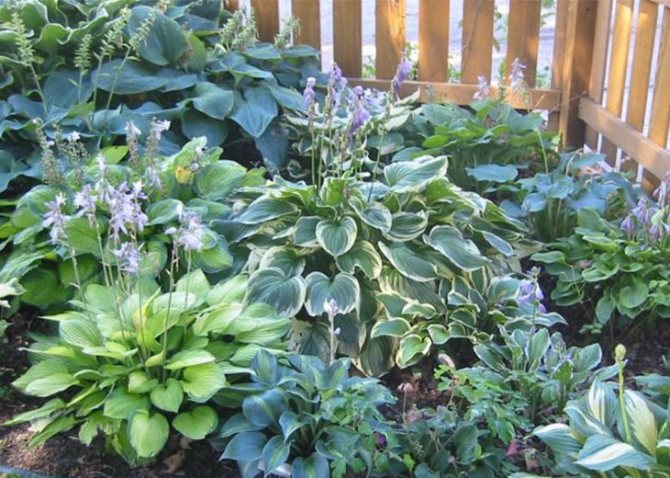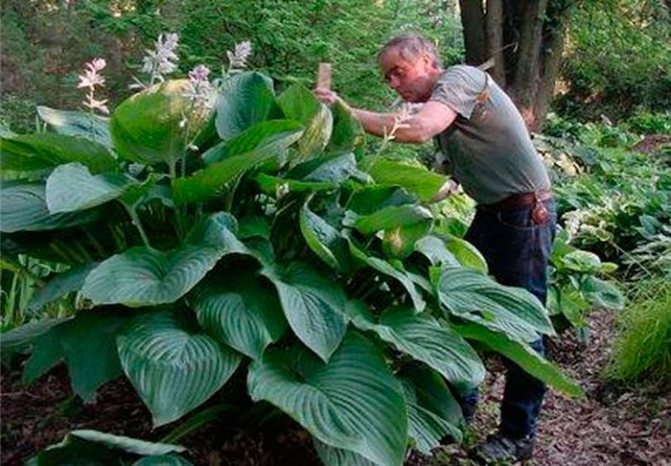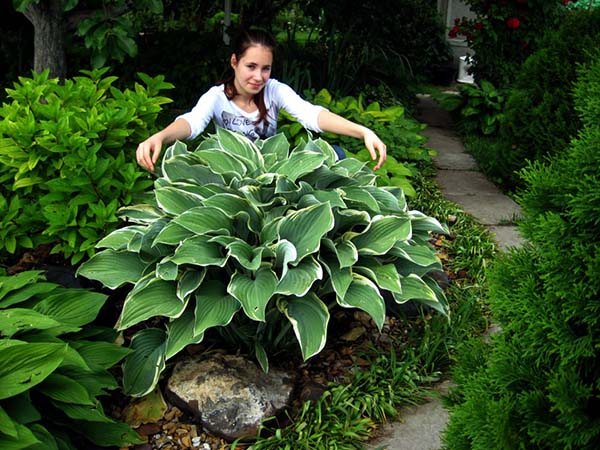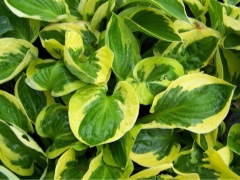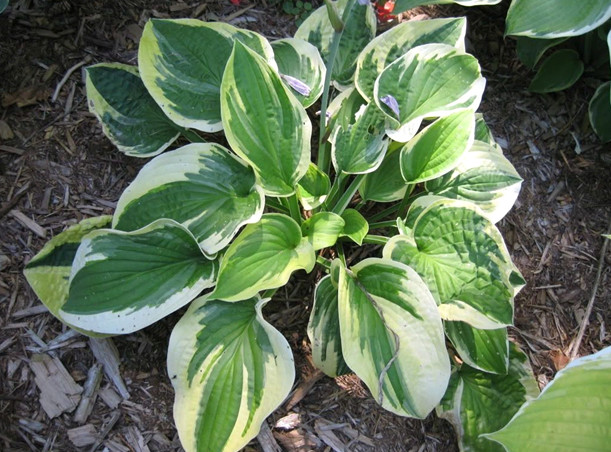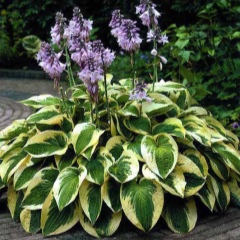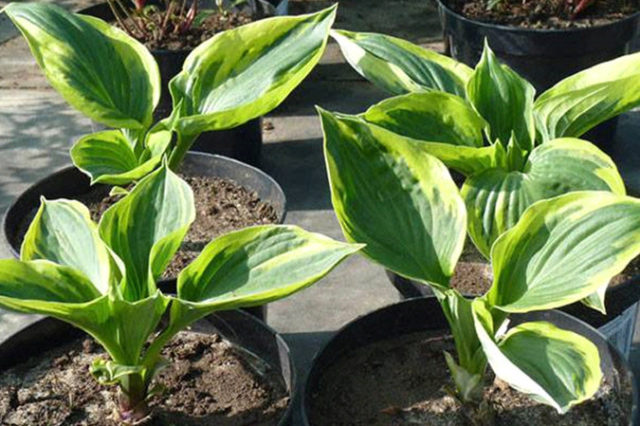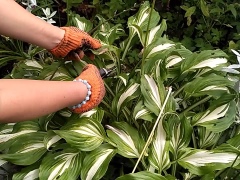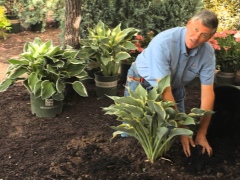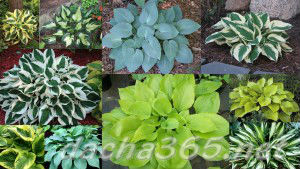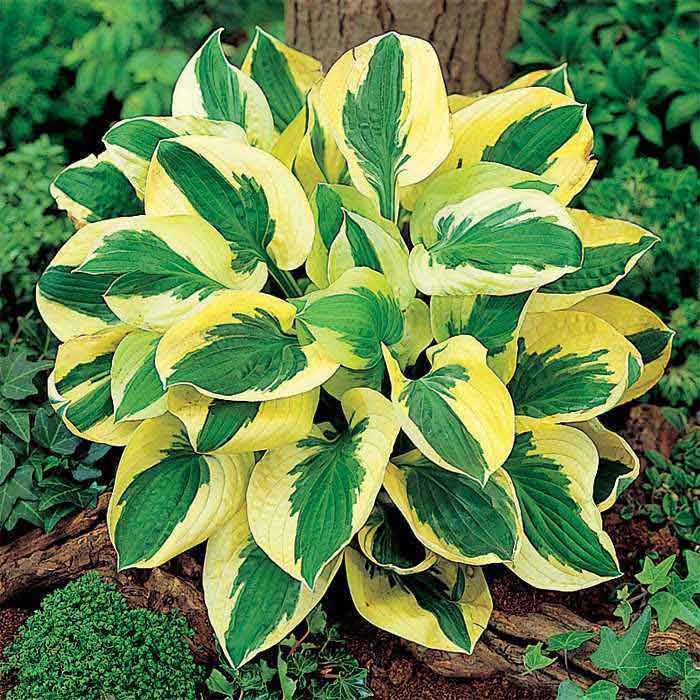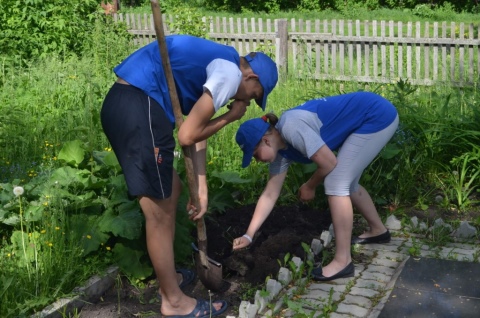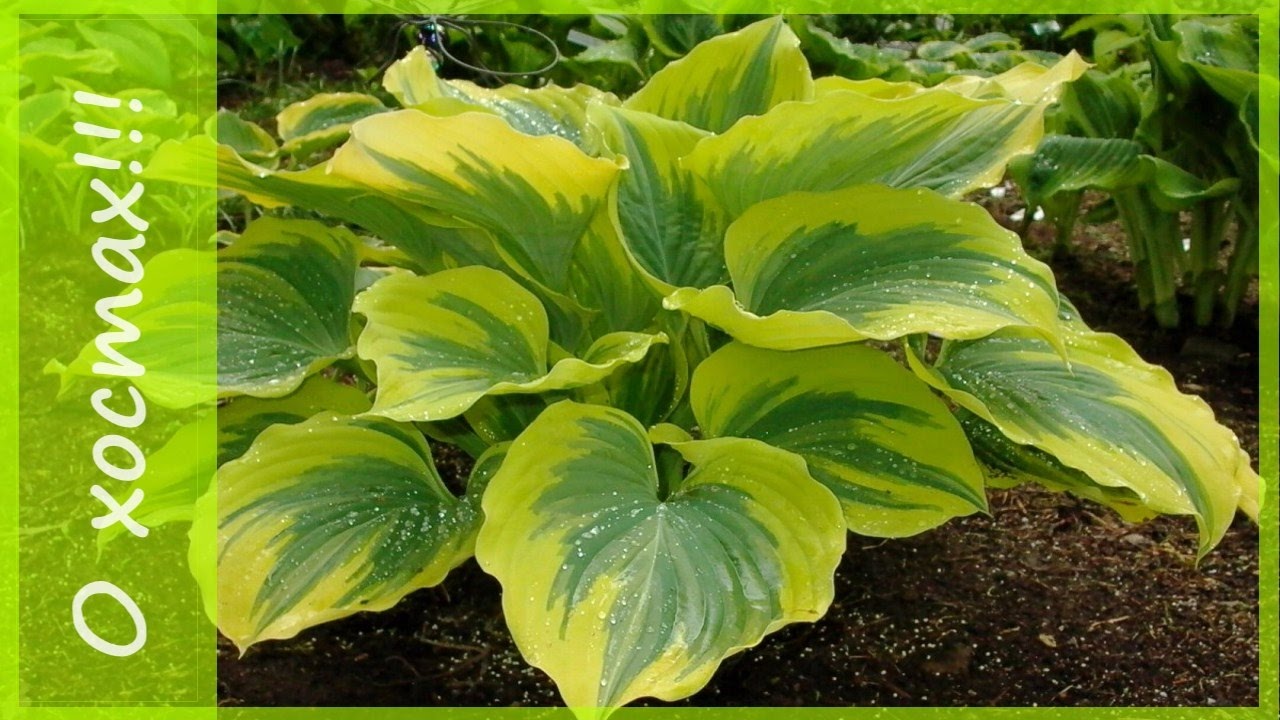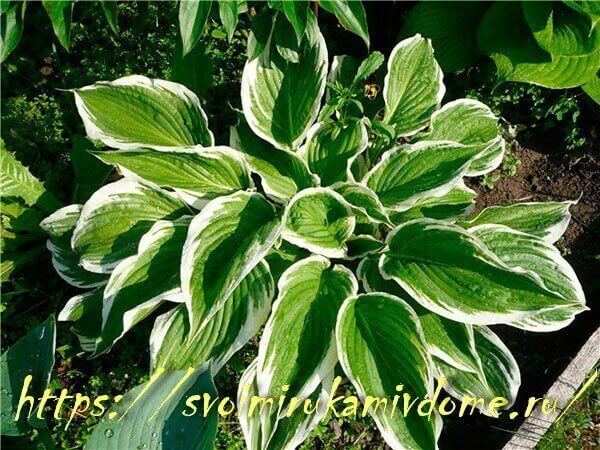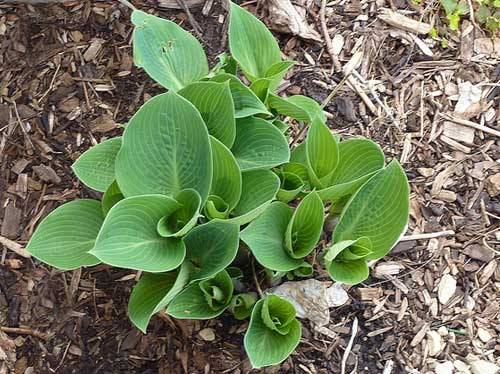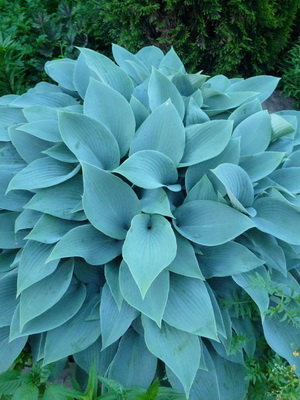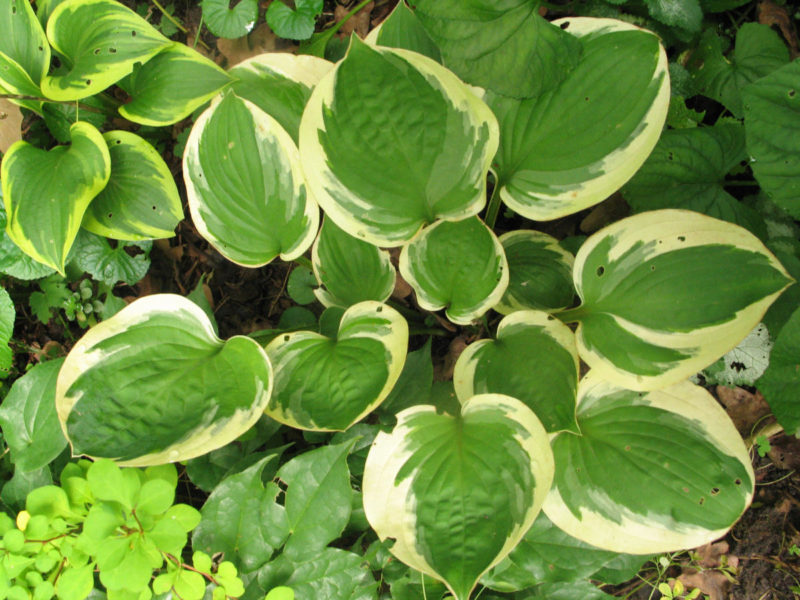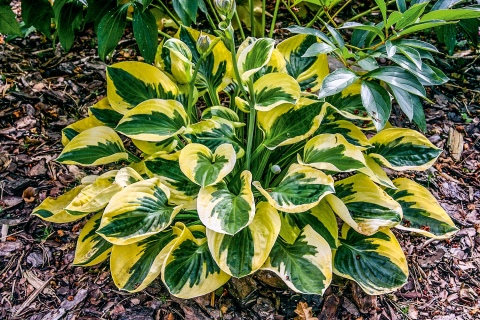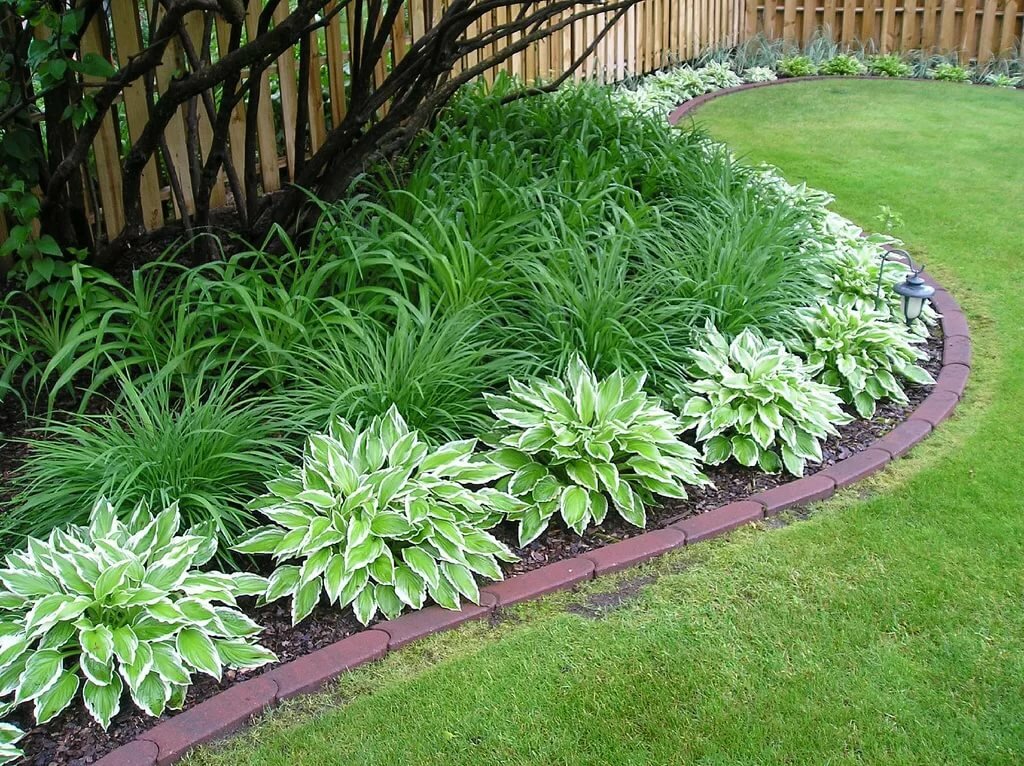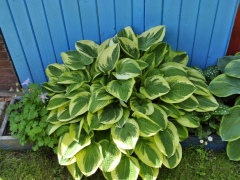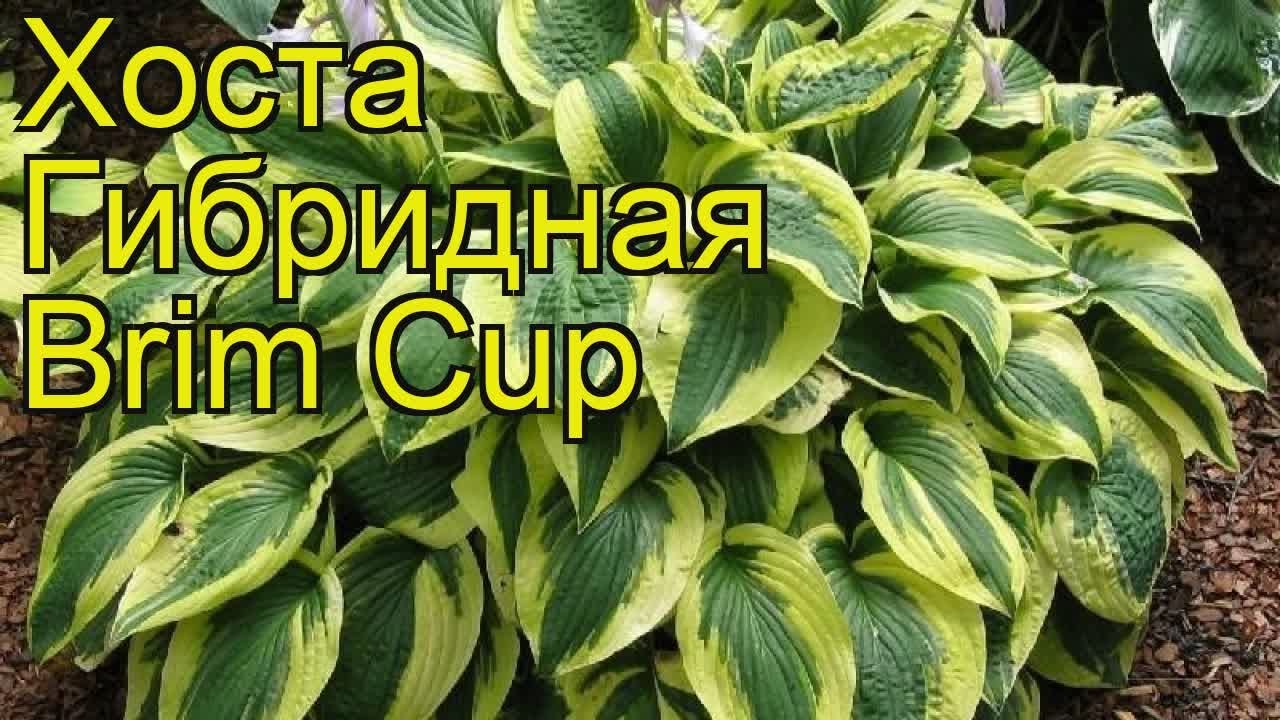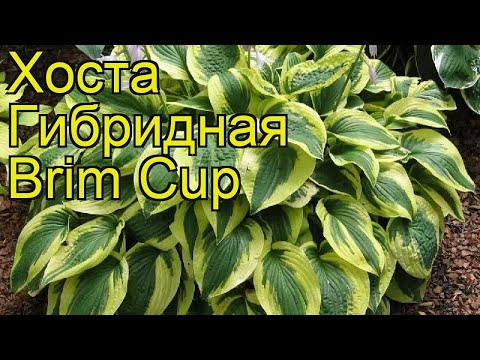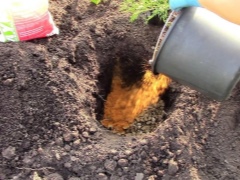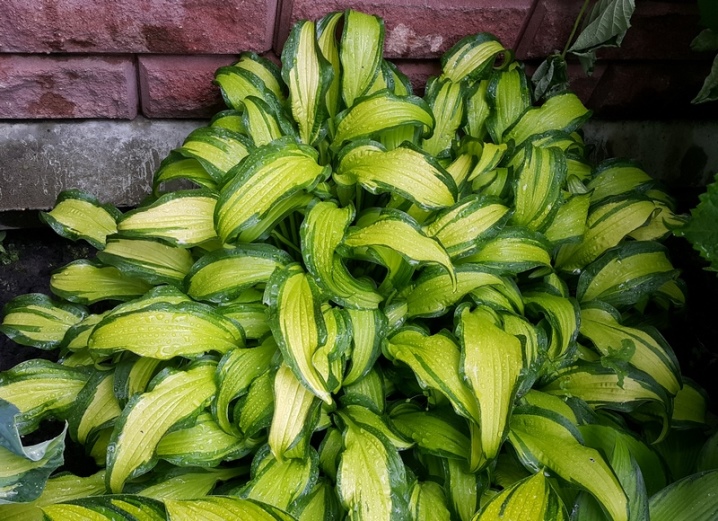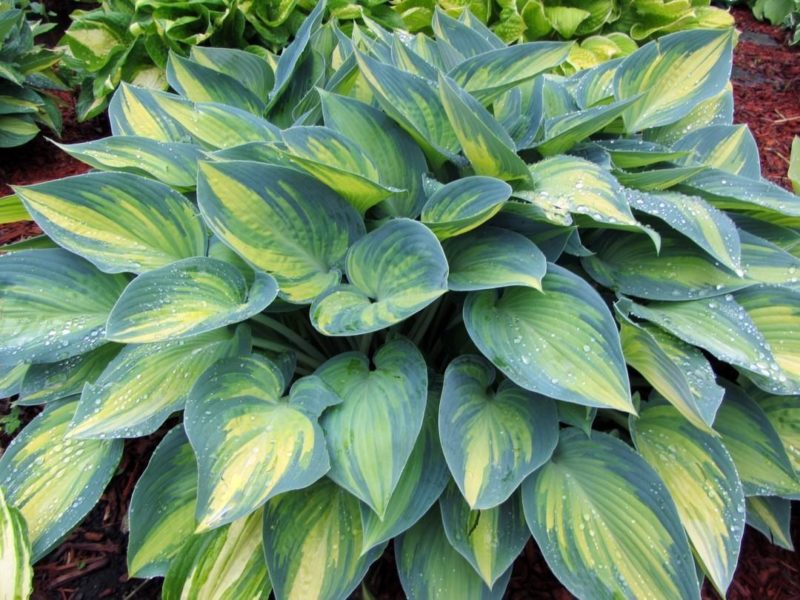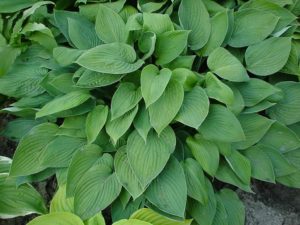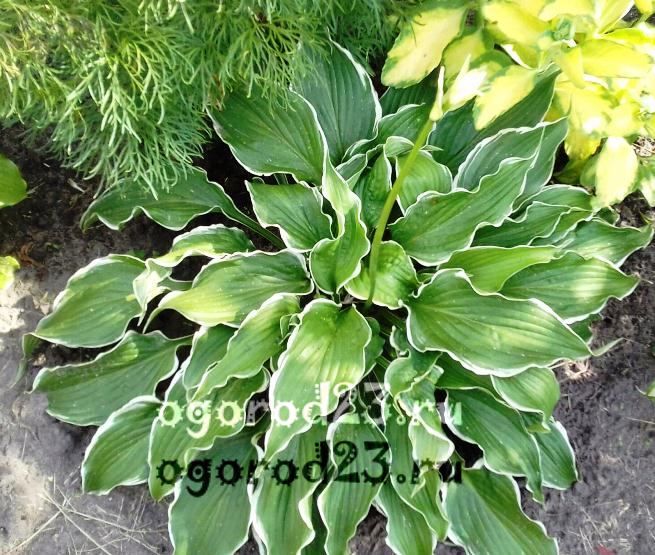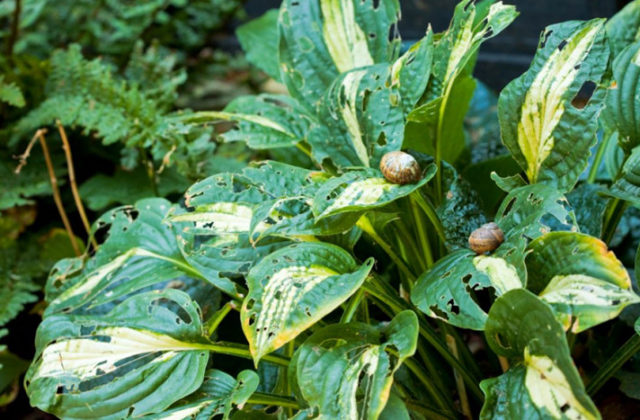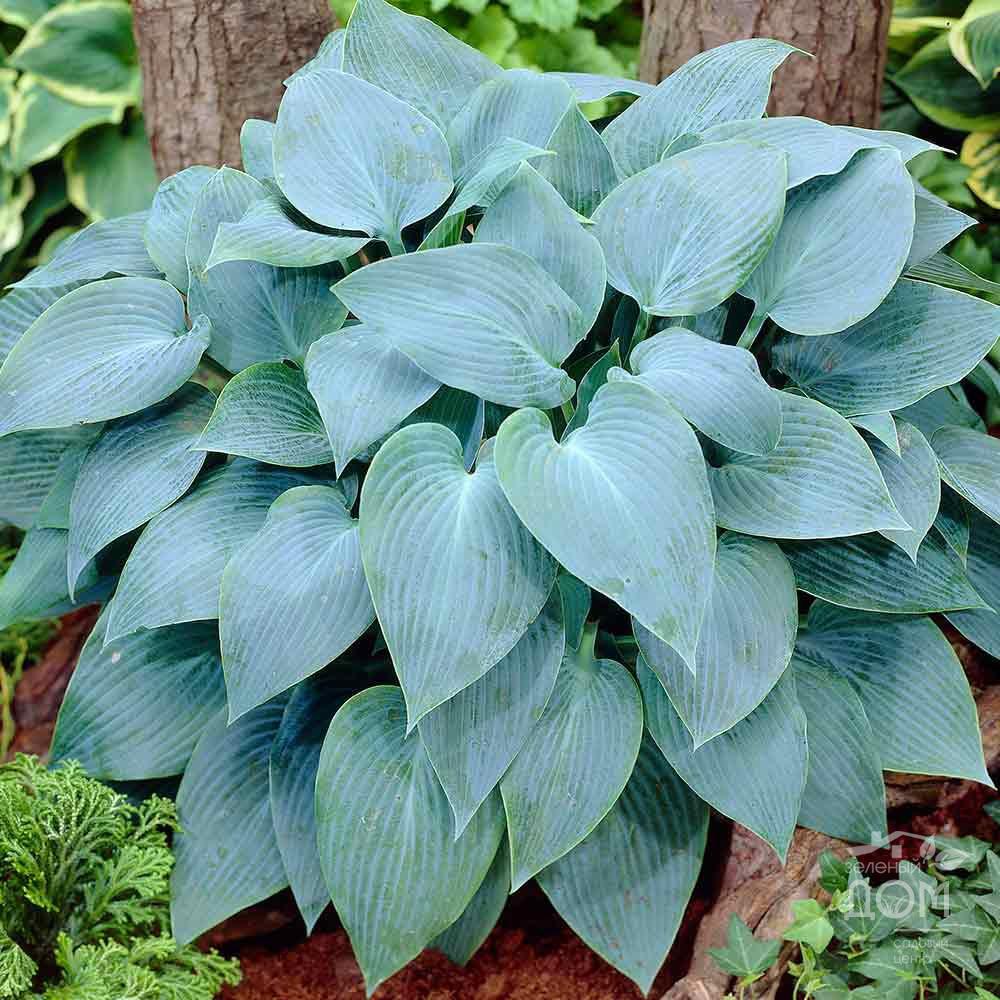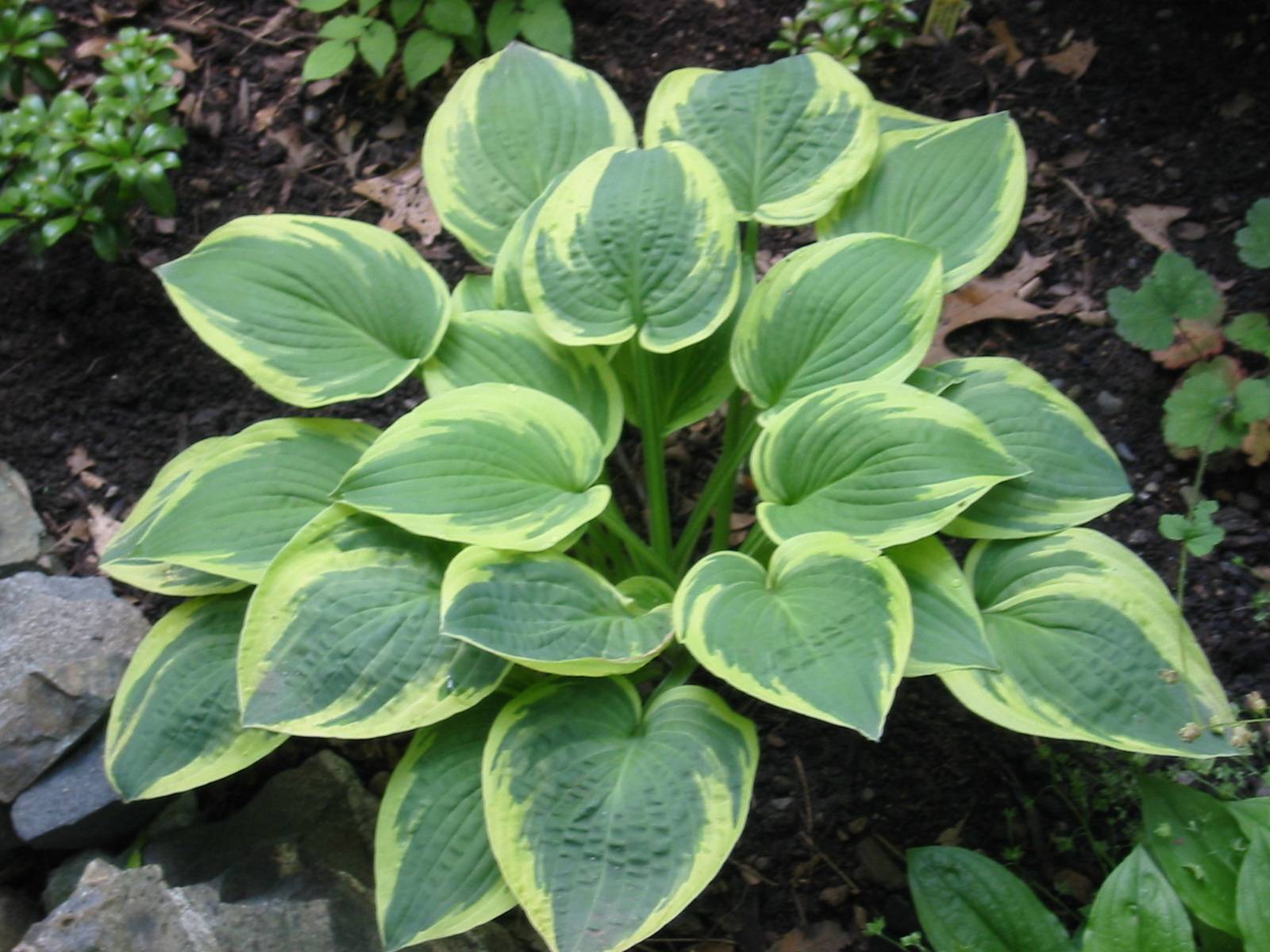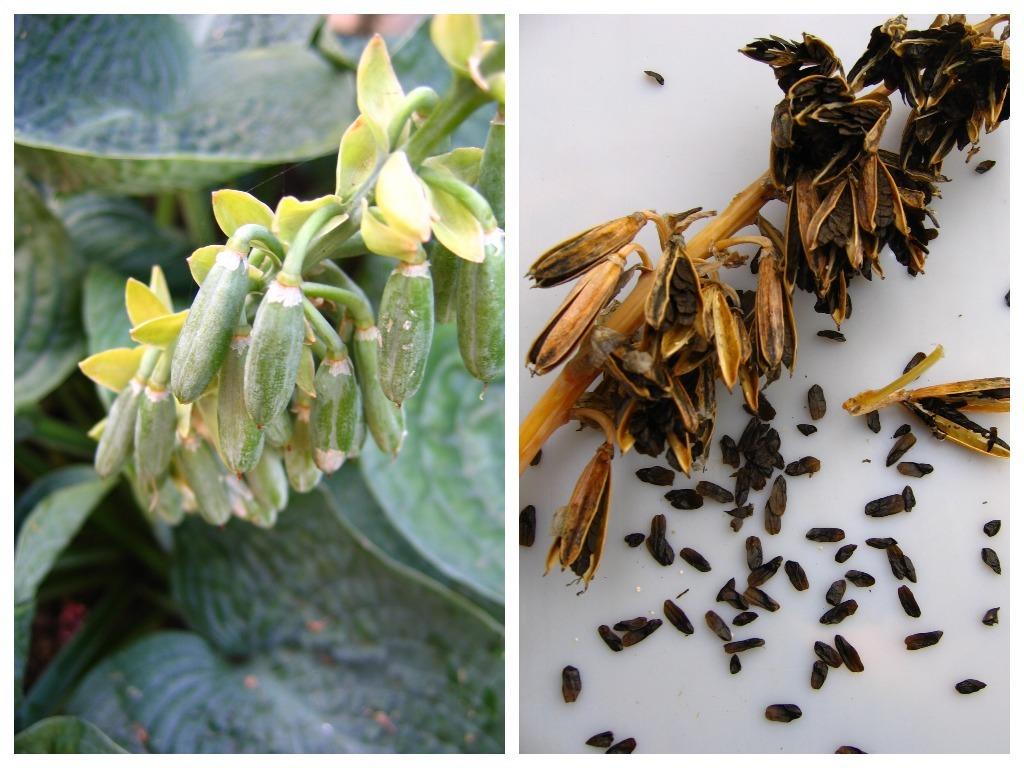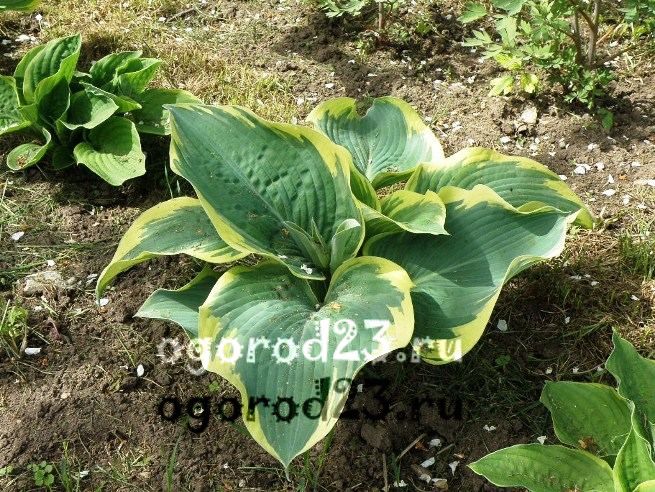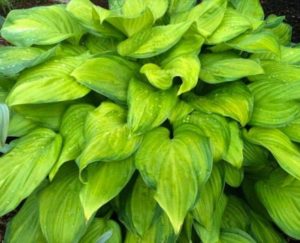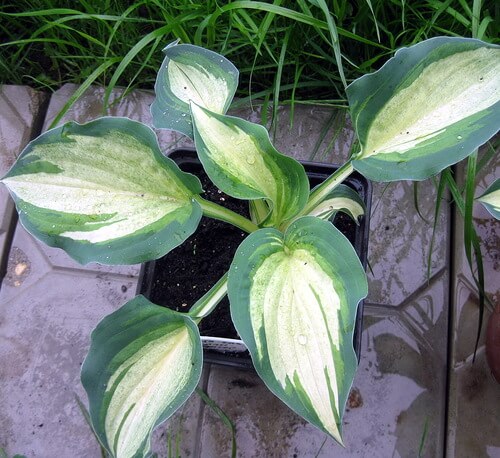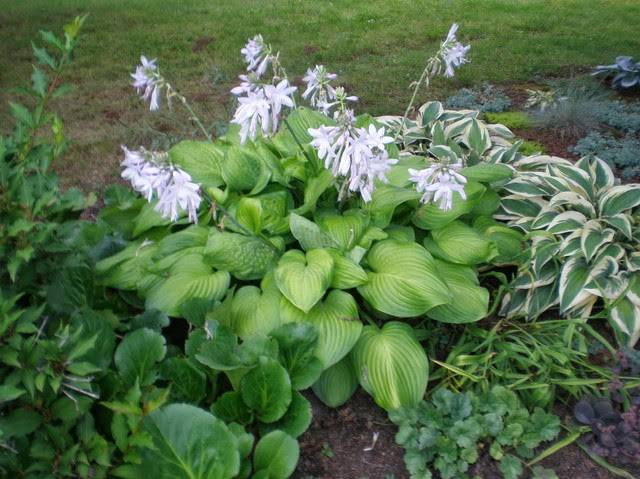Hosta "Brim Cap": description, planting, care and reproduction
The hosta plant, which attracts attention with its beautiful lush foliage, is increasingly becoming an object of interest for landscape designers. Culture is no less popular in gardening circles - it is appreciated for its undemanding care
Hybrid species, for example, "Brim Cap", are just as picky.
Description
Variety Brim Cup is an aesthetic, sparse shrub, reaching a height of 40 cm. Leaf plates measuring 16x13 cm are distinguished by a somewhat elongated shape, the color of the foliage is dark green with a bluish tint and a yellow frame, which gradually acquires a soft cream color. The inner part of the sheet is characterized by a matte surface and a bluish tint.
Flowering occurs in mid-July. The flowers are funnel-shaped, often collected in a one-sided inflorescence. The blossoming buds are light blue in color, and the opened flowers turn white. Flowers are located on stems up to 45 cm long. The variety is frost-resistant and can be grown in most regions of Russia.
Younger specimens have a more impressive appearance. They look great in both single and collective plantings. Suitable for curbs, ridges, mixed groups. Beautiful near water bodies.
How to plant?
Brim Cap grows well in moist, slightly acidic soils - this fact should be borne in mind when choosing a place for planting. And also it should be a shaded area, sheltered from gusts of wind. For successful cultivation, fertile, drained soil is suitable. The most favorable time for disembarkation is the first days of September. The planting process is as follows:
- dig up the flower bed;
- dig small planting holes, keeping a gap of about 50 cm between them, as the culture grows well;
- lay a drainage layer on the bottom;
- add fertilizer;
- place the seedlings on top, gently straightening the root system;
- moisten the planting site well;
- mulch the area, for example, with sawdust, crushed tree bark or peat.
How to care?
Caring for a hybrid variety is not difficult, although some rules should be followed. A competent approach to cultivation will ensure lush and abundant flowering. When caring for a plant, consider a number of points.
- Watering. The soil should be moistened often with large portions of water, since it is a moisture-loving culture. It is advisable to carry out the procedure in the morning. At the same time, do it in moderation to avoid stagnant water.
- Fertilizers. The specimens that are planted in depleted soil need additional fertilizing. Usually fertilizers are applied 3 times per season. Rotted organic matter and ready-made commercial mixtures for decorative deciduous crops are suitable as additional nutrition.
- Loosening. Loosen the soil very carefully as the root system is close to the ground. Removing the weeds is usually unnecessary, as the plant itself does not allow the weeds to develop.
- Pruning. This procedure is carried out in the autumn. The process involves removing the peduncles, while leaving the leaves.
- Transfer. The culture needs replanting every year, this is done in the fall.
How to propagate?
For breeding, you can use planting material or seedlings from a special nursery, you can ask your neighbors for it if they already have such a flower growing on their site, or it is possible to propagate it yourself in one of the ways.
- Division of the bush. This procedure takes place in April or September. First, an adult plant is watered abundantly, then removed from the ground and divided into parts with a sharp knife or shovel. Each beat must contain at least 2 sockets. The resulting parts are planted at a distance of 40 cm from each other.
- Cuttings. The essence of the method consists in cutting off the appendix, which has a root zone.There is no need to dig up the plant itself. The stalk is planted in a shaded area, and covered with a plastic cup on top. Within a few days, the sprout will be ready for transplantation to a permanent place.
- Sowing with seeds. This is the rarest and most unpromising method of reproduction, since the seeds of this culture are characterized by low germination. The resulting planting material must be soaked in a growth stimulant solution, and then sown in small containers and covered with foil. For several weeks, the planting site is regularly moistened, and soon the first shoots can be observed.
Reproduction of hosts by dividing the bush in the video below.
Features of agricultural technology
Meadows hosts are unpretentious and grow anywhere in the garden. A dry slope, a wet lowland, and an area under trees are suitable.
The choice of location is determined by the color of the foliage. For Hosta Golden, a place with partial shade is suitable, for example, in the shade of trees, since it needs a little sunlight to acquire a beautiful golden color. If there is no moderately shaded area, then place the hosta on the west or north side of other large flowers. It is watered a lot, the soil is mulched with compost.
Landing hosts
When planting, you must adhere to the recommended depth. The root collar should be 4 to 5 centimeters deep. Otherwise, on the one hand, the roots will begin to rot, on the other, they will be pushed to the surface.
This is a plant with large dimensions and leaves. A lot of moisture constantly evaporates from it. The soil must be moistened so that large and lush leaves will grow. It is especially necessary to water the young growth. To prevent the soil from becoming very compacted, water should be watered with a jet with a medium pressure. The soil should be soaked 10-15 centimeters. Watering is carried out either in the morning or in the evening. In sandy areas, the hostu is watered every day. If there is a lack of moisture, darkening will appear on the tips of the leaves.
Soil for Meadows:
- Nutritious neutral;
- Slightly acidic.
Compost and sand will have to be added to heavy clay soil, peat and leaf humus to dry and loose soil.
Growing in pots
It is undesirable to replant adult bushes that have been growing for more than 10 years. This can negatively affect them. If a transplant is needed, then they do it in the spring or in late August - early September. Water the seedling 20-30 minutes before placing it in the ground. Leave a distance of 30-40 cm between the bushes. Water for two weeks daily.
Organic fertilizers are added as a subcrust: humus and compost, and during planting, a complex of minerals is poured into the pit. In acidic soils, PH is normalized with dolomite flour or ash. Mulch with humus, mown grass, semi-decomposed sawdust. In autumn, such procedures are carried out to protect against frost when there is no snow.
Of mineral fertilizers, potassium, phosphorus and nitrogen are used in a ratio of 1: 2: 1. The first top dressing is in April (the beginning of leaf growth), the second - after 6 weeks, at the end of May, the final one - in July.
On a note. Flower arrows need to be broken off for an attractive appearance, as they break the symmetry of the bush. You can wait for the flowers to dry and remove them.
It is necessary to cut off shoots with buds after flowering, apply fertilizers by the end of July, cover the ground with mulch and add tobacco dust from pests there, treat with fungicides (Fitosporin), cover with dry branches. Film, roofing felt and other poorly permeable materials cannot be used for insulation.
Important! If after winter shoots do not appear for a long time, do not be afraid. The host may be late in germination, as it will expect constant heat.
Reproduction:
- Seeds. It is difficult to germinate the hosta in this way, so gardeners do not recommend it. With this reproduction, the plant will become decorative only by the age of 4.
- Division of the bush. The rhizome can be successfully divided throughout the season, but is best done in spring and early fall. To reduce evaporation, part of the leaves must be removed. The separated part is planted and watered. Young leaves will appear soon.
- Cuttings. When dividing the bush, stem cuttings are formed. Part of the roots with a bud are placed in a greenhouse. After a short time, they grow up.
Reproduction
Diseases of hosts
As mentioned above, the hosta Wide Brim is susceptible to certain diseases. Among them are various viruses that appear as rusty spots on the leaves. Over time, they grow, join together, the sheet dries and curls. It is impossible to help such a plant. It should be dug up and burned. It is not necessary to throw it out on the compost heap. Because the virus can spread to other plants through humus. Disinfect your work equipment after work.
Phylosticosis manifests itself in the same way as a viral disease, with rusty, brown spots on the leaves. The spots grow and merge into one. The leaf seems to be covered with bloom. Then they curl up and dry up.
Phylosticosis on hosta leaves. Photo from ask.extension.org
To get rid of this disease, cut off all diseased leaves and burn them, treat the rest with Abiga-Peak or Strobi preparations in accordance with the instructions. The procedure is repeated after 10 days. Supplement treatment with copper sulfate or colloidal sulfur.
Botrytis - manifested by gray rot on the leaves. At first it appears from the edge, later it goes to the whole sheet. To stop the disease, the rotten leaves are removed, and the plant is sprayed with Bordeaux liquid, Cuproscat, Topaz or Champion.
Botrytis on hosta leaves
Root collar rot - plant growth slows down, leaves begin to brighten.
To combat the disease, cut off all affected areas and treat them with a fungicide. Transplant the plant to another area or pot. And replace the land on which the hosta grew.
Care, watering, feeding
Despite the simplicity of growing these small plants, they have some preferences, the fulfillment of which will allow the bush to delight you with its attractiveness for many years. The host has a small size and, accordingly, a small root system. She is very sensitive to lack of moisture and its excess. Watering must be done frequently, but in moderation, so that there is no stagnation of moisture. Well-drained soil will help with this. Use fine gravel mulch or bark for this.
As for planting in a flower bed, the hosts must be planted in several bushes and protected with a dug-in plastic tape. This is necessary so that they do not get lost in the flower bed against the background of other plants. Also, the tape will serve as additional protection against pests, only in this case its height above the ground should be at least 7-10 cm. The tape will also protect against the spread of the roots of neighboring plantings.
When preparing for winter, the bushes must be covered with leaves or sawdust. In the spring, it will be good to do mulching with a thin layer of peat. Additionally, you can crush around with wood chips or bark - this will protect against slugs and retain moisture. If you decide to propagate the shrub by dividing, then it is better to do this in August. Use plants that are more than 3 years old and carefully separate the roots so as not to harm the host. Shoots of small hosts are not cut off in autumn, as they are an additional shelter from frost, and in spring they will serve as a beacon about the place of growth of the shrub. As soon as fresh shoots hatch in the spring, the dried ones can be safely removed.
You can fertilize the plant with granular balanced dressings. Once in the spring, when there is still snow, you can just scatter them under the bush, the second time - at the beginning of summer. You should not fertilize later, as this can provoke loose leaves and be a bait for slugs and snails. Do not plant hosts among large shrubs and trees. When the leaves from large plantations fall off, at the first rains, the leaves of the hosta itself under the fallen leaves may begin to rot and become covered with spots.
Among the miniature hosts, there are very finicky varieties. For example, the likes of Itsy Bitsy Spider. With a maximum height of 5 cm and a width of 18 cm, it takes a long time to grow.Suffers if moisture is in excess, and suffers from prolonged melting of snow. It is advisable to plant it separately in a small pot with a diameter of 7 cm.
Hosta "Brim Cap": description, planting, care and reproduction
The hosta plant, which attracts attention with its beautiful lush foliage, is increasingly becoming an object of interest for landscape designers. Culture is no less popular in gardening circles - it is appreciated for its undemanding care. Hybrid species are just as picky, for example, "Brim Cap"
Hybrid species, for example, "Brim Cap", are just as picky.
Description
Variety Brim Cup is an aesthetic, sparse shrub, reaching a height of 40 cm. Leaf plates measuring 16x13 cm are distinguished by a somewhat elongated shape, the color of the foliage is dark green with a bluish tint and a yellow frame, which gradually acquires a soft cream color. The inner part of the sheet is characterized by a matte surface and a bluish tint.
Flowering occurs in mid-July. The flowers are funnel-shaped, often collected in a one-sided inflorescence. The blossoming buds are light blue in color, and the opened flowers turn white. Flowers are located on stems up to 45 cm long. The variety is frost-resistant and can be grown in most regions of Russia.
Younger specimens have a more impressive appearance. They look great in both single and collective plantings. Suitable for curbs, ridges, mixed groups. Beautiful near water bodies.
How to plant?
Brim Cap grows well in moist, slightly acidic soils - this fact should be borne in mind when choosing a place for planting. And also it should be a shaded area, sheltered from gusts of wind. For successful cultivation, fertile, drained soil is suitable. The most favorable time for disembarkation is the first days of September. The planting process is as follows:
- dig up the flower bed;
- dig small planting holes, keeping a gap of about 50 cm between them, as the culture grows well;
- lay a drainage layer on the bottom;
- add fertilizer;
- place the seedlings on top, gently straightening the root system;
- moisten the planting site well;
- mulch the area, for example, with sawdust, crushed tree bark or peat.
How to care?
Caring for a hybrid variety is not difficult, although some rules should be followed. A competent approach to cultivation will ensure lush and abundant flowering. When caring for a plant, consider a number of points.
- Watering. The soil should be moistened often with large portions of water, since it is a moisture-loving culture. It is advisable to carry out the procedure in the morning. At the same time, do it in moderation to avoid stagnant water.
- Fertilizers. The specimens that are planted in depleted soil need additional fertilizing. Usually fertilizers are applied 3 times per season. Rotted organic matter and ready-made commercial mixtures for decorative deciduous crops are suitable as additional nutrition.
- Loosening. Loosen the soil very carefully as the root system is close to the ground. Removing the weeds is usually unnecessary, as the plant itself does not allow the weeds to develop.
- Pruning. This procedure is carried out in the autumn. The process involves removing the peduncles, while leaving the leaves.
- Transfer. The culture needs replanting every year, this is done in the fall.
How to propagate?
For breeding, you can use planting material or seedlings from a special nursery, you can ask your neighbors for it if they already have such a flower growing on their site, or it is possible to propagate it yourself in one of the ways.
- Division of the bush. This procedure takes place in April or September. First, an adult plant is watered abundantly, then removed from the ground and divided into parts with a sharp knife or shovel.Each beat must contain at least 2 sockets. The resulting parts are planted at a distance of 40 cm from each other.
- Cuttings. The essence of the method consists in cutting off the appendix, which has a root zone. There is no need to dig up the plant itself. The stalk is planted in a shaded area, and covered with a plastic cup on top. Within a few days, the sprout will be ready for transplantation to a permanent place.
- Sowing with seeds. This is the rarest and most unpromising method of reproduction, since the seeds of this culture are characterized by low germination. The resulting planting material must be soaked in a growth stimulant solution, and then sown in small containers and covered with foil. For several weeks, the planting site is regularly moistened, and soon the first shoots can be observed.
Reproduction of hosts by dividing the bush in the video below.
Hosts: varieties and types
All variety of host varieties, depending on their growth, are conventionally divided into the following groups:
- Mini category - miniature hosts, whose height does not exceed 15 cm (Miniature);
- category D - dwarf hosts that do not even reach 10 cm in height (Dwarf);
- category S - small hosts, the height of which ranges between 15 and 25 cm (Small);
- category M - medium hosts (Medium, 25–45 cm);
- category L - large hosts, from 45 to 70 cm (Large);
-
category G - giant hosts, more than 70 cm tall (Giant).
Miniature varieties include:
- Lakeside Little Tuft;
- Delia (Delia);
- Little Jim.
Dwarf hosts are:
- Blue Ice;
- Blue Moon;
- Sparky.
The category of small hosts includes varieties:
- Kelly Fries (Curly Fries);
- host Stiletto;
- Niagara Falls;
- Mighty Mouse
- Pizzazz
- Raspberry Sundae;
- Luna Moth;
- Minuteman;
- Snake Eyes
-
host Rainbows End.
Medium hosts include:
- host June (June);
- host Golden Tiara;
- host Brim Cap;
- Paradise Island;
- host Orange Marmalade (Orange Marmalade);
- host CherryBerry (CherryBerry);
- Christmas Three (ChristmasTree);
- host Carnival;
- Avocado (Avocado);
- Paul's Glory or Paul's Glory;
- August Moon;
- Moon Split (MoonSplit);
- Firn Line (FirnLine);
- Thunderbolt
- Sun Power (SunPower);
- Wolverine or Wolverine;
- El Niño (ElNino);
- Canadian Blue (CanadianBlue);
-
Spartacus (HostaSpartacus);
- Tokudama Flavocircinalis (TokudamaFlavocircinalis);
- Yellow River (YellowRiver);
- Revolution;
- Color Glory (ColorGlory);
- Allegan Fog
- Abiqua Drinking Gourd
- Bullfrog
- Beach Boy;
- France (France);
- Restless Sea;
- Snow Cap (SnowCap);
- Patriot
- First Love (FirstLove);
- Warwick Comet
- Hanky punks (HankyPanky);
- host Blue Ivory;
- Pathfinder
- Sunset Grooves
- Ripple Effect;
-
Magic Island (MagicIsland);
- Night Beefo Christmas (Night Before Christmas);
- Red Oktober (RedOctober);
- Lakeside Cupcake;
- Merlin Monroe (Marilyn Monroe);
- Lady Guinevere;
- Benverny (Ben Vernooij);
- Spilt Milk;
- Colored Hulk
- Fire Island;
- Love Pat;
- Gooseberry Sunday;
- Autumn Frost;
- Invisible (Invincible);
- Lakeside Banana Bay;
- Ghost Spirit;
- Paradise Joyce.
Large host varieties:
- host Kiwi Full Monty;
-
host American Halo;
- Bressingham Blue or host Bressingham Blue;
- Twilight or Twilight;
- Aureomarginate;
- Saint Paul;
- Hosta Guacamole
- Atlantis;
- Regal Splendor
- host Catherine;
- Robert Frost
- Cross Regal (KrossaRegal);
- Sharman (Sharmon);
- Eskimo Pie;
- Antioch
- Neptune
- Guardian Angel
- ForbiddenFruit
- Great Expectations;
- Christmas Candy (Christmas Candy);
- Sugar Daddy (SugarDaddy);
-
Mata Hari (MataHari);
- Majesty;
- Blue Mammoth;
- Inniswood;
- Zounds
- Brother Stephan (Brother Stephan);
- Summer Breeze
- Dancing Queen (DancingQueen);
- Velvet Moon
- AbiquaMoonbeam;
- Paradigm (Paradigm);
- Delta Down (DeltaDawn).
The giant host group includes:
- Dream Queen;
- Saga (Saga);
- Empress Wu or Empress Wu;
- Big Daddy (BigDaddy);
- Blue Umbrellas;
-
Sagae.
Reproduction
The function of the Brim Cup is propagated by cuttings, dividing the bush and sowing seeds. The first two methods are used much more often than the third.

Hosta brim cup
Seed material is not always possible to get and it rarely retains the varietal characteristics of the plant.
Cuttings
Cuttings are cut "with the heel" and treated with a root stimulator. The earth in a shady place is loosened and moistened, and then the cut shoots are deepened.
Some of the leaves can be removed to reduce evaporation. Top cuttings are covered with plastic bottles.As the soil dries up, the seedlings are watered, and the cover is sometimes removed for ventilation.
By dividing the bush
It is recommended to divide adult bushes in early spring or autumn, but if necessary, this can be done in summer. The bush is dug up and divided into several parts. Each must contain at least one kidney. Delenki are seated in a damp and composted soil in partial shade.
Plant characteristics
Botanical Description of Host Albopict:
- Herbaceous ornamental plant, from 40 to 70 cm in height, grows in width to 60-80 cm in diameter.
- Glossy leaves are slightly wavy, initially painted in a yellow-green hue with a darker edging around the edges. By the end of summer, the color becomes more uniform and changes to a dull green.
- Flowers in the form of bells, collected in pale purple inflorescences, are located on tall pedicels, from 60 to 70 cm high. Flowering begins in July and lasts until the end of summer.
This is an unpretentious and shade-tolerant plant that can grow both in sunny areas and in the shade.
The flower of the host fortunei albopicta has become popular for its lush clumps of green foliage, which can become a real pearl of any landscape composition. The plant belongs to perennial crops and has the following characteristics:
- Unpretentious frost-resistant plant.
- The plant is undemanding to light. The host can be grown anywhere in the garden, but in semi-shady areas the plant reaches its maximum decorative effect. Different amounts of light affect the color intensity of the foliage in different ways. For example, in shaded areas, the leaves take on a rich yellow tint, in sunnier areas - a lighter tone.
- After flowering, in place of the inflorescences, seed pods are formed, filled with many flat-shaped seeds of black shades.
The flower grows rapidly and reaches its maximum decorative effect after a few years, after a huge head of lush foliage is formed, and the intensity of the color shades of the leaves will be maximum.
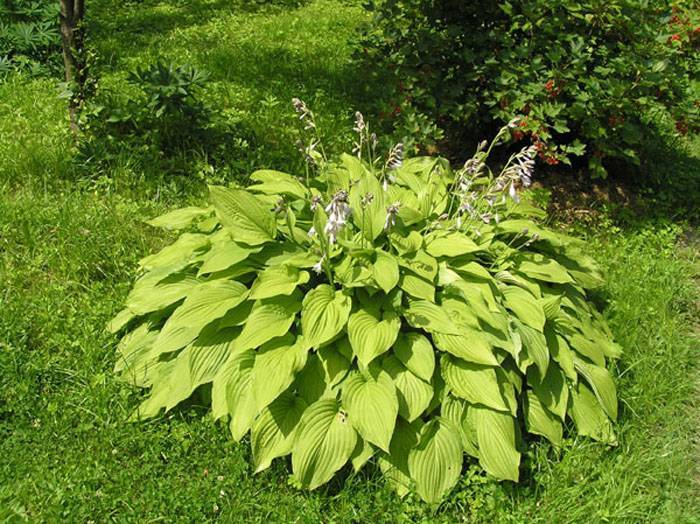
Hosta Albopicta


